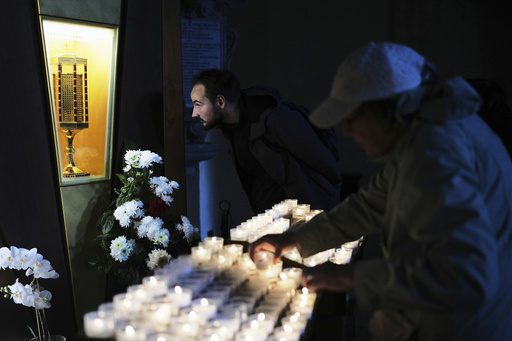Historical Plaque in Municipal Gardens Remembers Slain Black Man, Helps Ensure Painful Past is not Forgotten

This story was originally published by The Indiana CItizenOne hundred and three years after his body was found hanging from a sapling along the banks of the White River, George Tompkins is finally getting his story written into the pages of history.
Tompkins, a 19-year-old Black man living in Indianapolis with his aunt and uncle, left home in good spirits at 7:30 a.m. on March 16, 1922. Seven hours later, he was discovered with his hands tied loosely behind his back and a noose around his neck, with the other end of the rope knotted to a sapling in the woods of what is now Municipal Gardens Memorial Grove Park along Lafayette Road.
Initially, according to Indianapolis native and historian Leon Bates, the local police detectives and the coroner considered Tompkins’ death a homicide. Yet, two days later, detectives suggested Tompkins had taken his own life and the word “homicide” on his death certificate was scratched out with a pencil and “suicide” was scrawled in its place.
And with that, Bates said, Tompkins’ story disappeared for a century.
“There was no further investigation,” Bates said. “No one was ever brought to justice.”
However, on March 16, 2025, the tragedy of Tompkins’ slaying was publicly acknowledged and his life was commemorated during a special ceremony at Municipal Gardens. Bates and the Indiana Remembrance Coalition, along with the Alabama-based Equal Justice Initiative, a nonprofit fighting racial and economic injustice, worked together to research and write Tompkins’ story and then put it on a historical marker.
The ceremony began inside the community building at Municipal Gardens where several people spoke about the work and importance of recovering and restoring Tompkins’ story. After the speeches, the event moved outdoors so the crowd could get the first look at the historical marker.
Overlooking a bend in the White River, the marker – the first one EJI has placed in Indianapolis – was unveiled during the ceremony while the crowd, bundled in heavy coats, hats and gloves to fend off the frigid, raw day, gathered together to see the plaque and bear witness to the previously suppressed history.
Stephanie Wylie, staff attorney at the Equal Justice Initiative, called the marker an “act of justice.” The ceremony and plaque were meant to not only tell the truth about what happened to Tompkins but also ensure that history does not repeat itself, she told the crowd.
Tompkins was killed, Wylie noted, before he could build a life, and his loved ones could not grieve or celebrate him, because his death sent a strong message of violence and control. Unveiling the plaque was an opportunity to remember him not as a victim but as someone who was loved, who mattered and who had a life and dreams “that should have never been stolen.” Moreover, breaking the silence and commemorating him was giving some justice to Tompkins, she said.
“This memorial is more than just a marker,” Wylie said. “It’s a commitment to truth, a commitment to ensuring that this history continues to be told honestly. It’s a place for the community to come, to remember, to reflect and to confront the painful realities of our past. Today also represents an amazing step toward justice, because by remembering, by speaking the truth and by ensuring that stories like Mr. Tompkins’ are not erased, we move toward a future where these kinds of racial terror events are never repeated.”
Tompkins’ death fits the definition of lynching, according to Bates. A lynching is considered an “extrajudicial punishment,” which is typically carried out by three or more people and includes beating, flogging, whipping, cutting, stabbing, shooting or hanging, or, even just the threat of such action. He said the incident involving Tompkins was not a “classical lynching,” but the teenager was “intentionally killed.”
In addition, the sapling provided further evidence that what Tompkins endured was a crime and not a suicide. Bates, discrediting the original cause-of-death ruling, said the young tree was bent over, despite the young man’s small, 5-foot-4-inch-frame of just 150 pounds, and his feet were on the ground, so he could have stopped himself from choking by just changing position.
“There are more efficient ways to kill yourself than if you put a rope around your neck, tie it to a sapling and then sit down, because at some point it’s going to start becoming uncomfortable and the natural instinct is going to be to stand up,” Bates said.
While Tompkins’ body had no visible bruises, scrapes or scratches, his clothes were covered in weeds and leaves, indicating, Bates said, that he had been killed elsewhere and then dragged and tied to the sapling.
The Marion County Coroner’s Office changed Tompkins’ cause of death in 2022 because of the historical research done by Bates and the Indiana Remembrance Coalition. At the recent ceremony, Coroner Alfarena McGinty displayed a poster-sized copy of Tompkins’ death certificate, which had red boxes around “suicide,” listed as the original cause of death, and around “homicide,” now listed as the updated cause.
McGinty told the crowd she “had the privilege” of correcting Tompkins’ death certificate and helping to spotlight a truth that had been hidden for a century. The act was especially meaningful to her, because, she said, she grew up in Indianapolis, where the voices and histories of Black residents have too often been excluded from the community’s collective memory.
“That must change as we unveil the memorial,” McGinty said. “Let it not be a marker of past injustice, but also a call to action, a reminder that our work is not done. This justice is not about correcting history, it is about shaping our future, where no one’s life is disregarded, where no truth is buried and where everyone’s personal humanity is honored in life and death.”
At the unveiling, as the covering was pulled off the historical marker, several in the crowd held up their phones to record the event. Afterward, they paused for a moment of silence to remember Tompkins.
The plaque, blue with yellow lettering, is perched beside a peaceful respite area where visitors can relax and watch the water ripple and run between the riverbanks. When the ceremony ended, many braved the brutal weather a little longer to get a closer look at the marker and take a photograph.
Phyllis Hackett, historian for the Riverside Neighborhood Association, pointed out at the unveiling ceremony that the Tompkins marker was the result of many people working together to restore his story. She compared the effort to drops of water that are important and significant by themselves, but when they join with one another, they form a mighty river that flows into the ocean.
Hackett, who has been researching the history of her community since the 1960s, had heard rumors about lynchings, but her searches through newspapers and archives did not turn up any documentation about such events. Then, some people from the Indiana Remembrance Coalition reached out with the story about Tompkins and, she said, the drops of knowledge she had were added to the drops of information they had, so, eventually, his story could be told.
Some people in her neighborhood were not comfortable uncovering the details of Tompkins’ death, preferring to keep it hidden, but, she said, speaking the truth is important.
“It’s a special day for our city, because if you look and you see the curves of the river and you see the coming of spring and you see the shadows of fall and winter and what is being left behind, you see that we live in a life that is a life of wonderment,” Hackett said. “We’re entitled to see that in the eyes of both beauty, but also to understand that there were those who were here before us that did not get to have the opportunities that we currently have.”
The Indiana Citizen is a nonpartisan, nonprofit platform dedicated to increasing the number of informed, engaged Hoosier citizens. We are operated by the Indiana Citizen Education Foundation, Inc., a 501(c)(3) pu
The post Historical Plaque in Municipal Gardens Remembers Slain Black Man, Helps Ensure Painful Past is not Forgotten appeared first on Capital B Gary.




